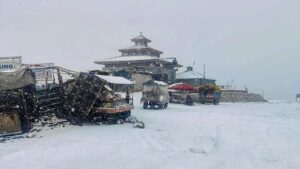Context

Kashmir witnessed an early onset of winter as unseasonal snow and rain hit the upper reaches and plains in early October — nearly a month ahead of the usual timeline. The event brought delight to tourists while causing travel disruptions and indicating a shifting local climate pattern.
Meteorological Highlights
- Sudden temperature drop:
- Gulmarg: Minimum −0.4 °C (6.4 °C below normal); maximum 4.4 °C (12.1 °C below normal).
- Pahalgam: Minimum 0.6 °C (4.5 °C below normal); maximum 9.2 °C (13.2 °C below normal).
- Srinagar: Maximum 12.5 °C (13 °C below normal); minimum 9 °C.
- Zojila Pass: Minimum −8 °C (first sub-zero reading of the season).
- Areas affected:
Snow reported from Gulmarg (Kongdoori, Affarwat), Pahalgam, Sonamarg, Daksun (Kokernag), and high passes — Sadhna, Razdan, Zojila, Sinthani, and Pir Ki Gali. - Impact: Closure of Srinagar–Jammu, Srinagar–Poonch, and Srinagar–Kishtwar highways due to heavy snowfall.
Implications
- Tourism Boost:
Early snow turned Kashmir’s resorts into winter wonderlands, drawing tourists who rarely experience snow before November. The timing could extend the tourist season, benefiting the hospitality economy. - Transport & Connectivity Challenges:
Closure of mountain passes like Zojila and Razdan disrupted supply routes and communication with Ladakh and border regions along the LoC — highlighting strategic vulnerability in logistics and defence mobility. - Climatological Angle:
The event underscores the increasing variability of Western Disturbances, the Mediterranean-origin storms that bring winter precipitation to North India.
Such anomalies — earlier or more intense snowfall — may be linked to climate change–driven jet stream shifts and regional temperature differentials. - Environmental Consequences:
Early snow alters soil moisture balance, plant dormancy cycles, and river headwater runoff timing, affecting agriculture and hydroelectric output downstream.




